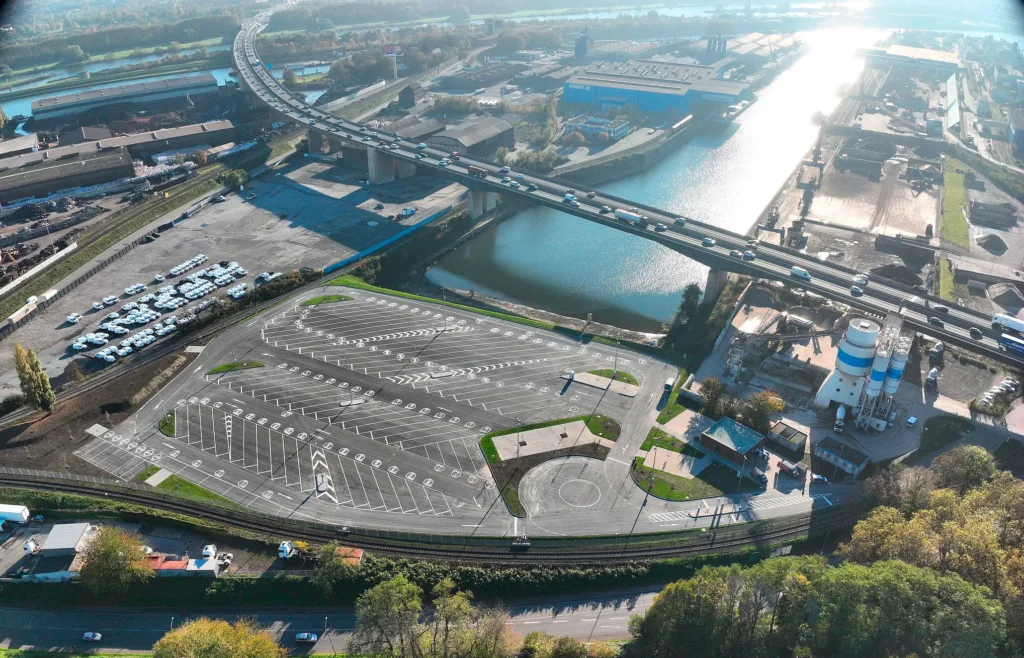Germany has been struggling with a structural shortage of truck parking spaces along its motorways for years. According to a survey by Autobahn GmbH alone, there was a shortage of over 20,000 parking spaces in 2023 – and the trend is rising. With the Hunsrück West Telematics Parking System project, the federal government now aims to counteract this and make more efficient use of existing capacity.
Making the best possible use of existing truck parking spaces – telematics parking systems help with this, writes the Federal Ministry of Transport, referring to the commissioning of the free parking spaces for trucks.
More capacity without new construction: 50 percent more parking spaces
The new system at the Hunsrück West rest area (A61) increases usable capacity from 50 to 78 parking spaces through a telematic allocation process – without any structural expansion. Including the existing additional areas, a total of 88 truck parking spaces are now available.
This densification through intelligent compact parking is seen as an opportunity, especially in locations with limited space or restrictive building regulations.
Telematics as a scalable solution – up to 50 systems by 2030
Federal Transport Minister Patrick Schnieder emphasises:
Logistics is one of the largest economic sectors in Germany (…). Thousands of truck drivers are on Germany’s roads every day, performing essential work. They need well-developed and easily accessible truck parking facilities for their rest breaks.
He also announced that the federal government intends to equip up to 50 additional rest areas with the new technology by 2030. To this end, Autobahn GmbH is setting up a Competence Centre for Telematic Parking, which will consolidate the planning, construction and operation of the systems.
The minister’s accompanying statement goes on to say that the procedure enables more efficient use of existing space, is a significant step forward – and that the federal government is investing around €900,000 in the new parking system.
Technical progress relieves pressure – but does not replace new construction
Dirk Brandenburger, Technical Director of Autobahn GmbH, also describes the system as a “quick digital solution” to make better use of existing space:
With the telematic parking system, we create a fast digital solution that optimally lines up trucks using dynamic displays.
ACE analysis: Dangerous conditions threaten night after night
A recent analysis by the Auto Club Europa (ACE) demonstrates how urgent this relief is. Between April and June 2025, the association examined 31 rest areas in eastern Germany – with alarming results:
- A total of 2,168 parked trucks were counted, although only 1,412 regular spaces were available – an overcrowding of around 50 percent.
- Particularly dramatic were the locations on the A4 near Bautzen (165 percent overcrowding) and on the A17 near Dresden (up to 120 percent).
- Specific traffic hazards were identified at 21 sites, such as trucks parked in entrances and exits or in spaces intended for cars.
It was noted positively that no vehicles were parked on the hard shoulder. Nevertheless, it is clear that pressure on the infrastructure is enormous – especially in the evenings.
Dirk Engelhardt, spokesperson for the board of the Federal Association of Freight Transport (BGL), speaks of a veritable “guerrilla war” from 4 p.m. onwards over the few available spaces.
Figures from the Federal Highway Research Institute (BASt) confirm this: in 2023, over 102,000 trucks were parked at night, compared to only 82,490 regular parking spaces. The BGL estimates the actual shortfall to be around 40,000 spaces – and warns that the expansion of charging infrastructure for electric trucks could further exacerbate the shortage.
Bottleneck remains – telematics only helps in the short term
The new parking system is an important stimulus, but no substitute for the widespread expansion of parking capacity. Policymakers are relying on digitalisation to buy time. However, the pressure to act remains high, because without major investment in new spaces and coordinated solutions involving private truck stops, nighttime parking will remain a risk for truck drivers in the future.









